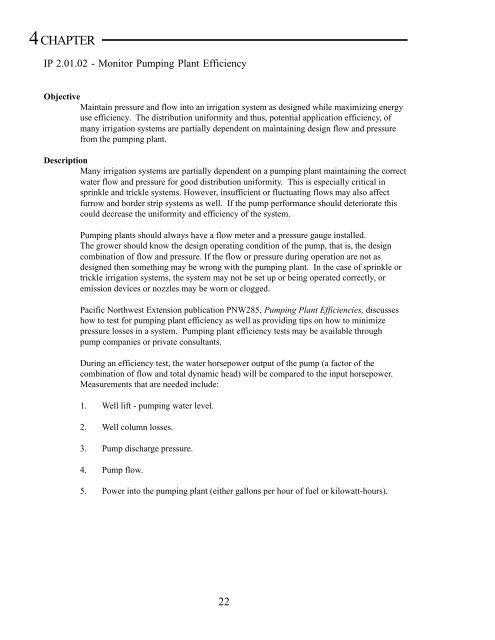Em4885 irrigation management practices to protect ground water
Em4885 irrigation management practices to protect ground water
Em4885 irrigation management practices to protect ground water
You also want an ePaper? Increase the reach of your titles
YUMPU automatically turns print PDFs into web optimized ePapers that Google loves.
4 CHAPTER<br />
IP 2.01.02 - Moni<strong>to</strong>r Pumping Plant Efficiency<br />
Objective<br />
Maintain pressure and flow in<strong>to</strong> an <strong>irrigation</strong> system as designed while maximizing energy<br />
use efficiency. The distribution uniformity and thus, potential application efficiency, of<br />
many <strong>irrigation</strong> systems are partially dependent on maintaining design flow and pressure<br />
from the pumping plant.<br />
Description<br />
Many <strong>irrigation</strong> systems are partially dependent on a pumping plant maintaining the correct<br />
<strong>water</strong> flow and pressure for good distribution uniformity. This is especially critical in<br />
sprinkle and trickle systems. However, insufficient or fluctuating flows may also affect<br />
furrow and border strip systems as well. If the pump performance should deteriorate this<br />
could decrease the uniformity and efficiency of the system.<br />
Pumping plants should always have a flow meter and a pressure gauge installed.<br />
The grower should know the design operating condition of the pump, that is, the design<br />
combination of flow and pressure. If the flow or pressure during operation are not as<br />
designed then something may be wrong with the pumping plant. In the case of sprinkle or<br />
trickle <strong>irrigation</strong> systems, the system may not be set up or being operated correctly, or<br />
emission devices or nozzles may be worn or clogged.<br />
Pacific Northwest Extension publication PNW285, Pumping Plant Efficiencies, discusses<br />
how <strong>to</strong> test for pumping plant efficiency as well as providing tips on how <strong>to</strong> minimize<br />
pressure losses in a system. Pumping plant efficiency tests may be available through<br />
pump companies or private consultants.<br />
During an efficiency test, the <strong>water</strong> horsepower output of the pump (a fac<strong>to</strong>r of the<br />
combination of flow and <strong>to</strong>tal dynamic head) will be compared <strong>to</strong> the input horsepower.<br />
Measurements that are needed include:<br />
1. Well lift - pumping <strong>water</strong> level.<br />
2. Well column losses.<br />
3. Pump discharge pressure.<br />
4. Pump flow.<br />
5. Power in<strong>to</strong> the pumping plant (either gallons per hour of fuel or kilowatt-hours).<br />
22
















